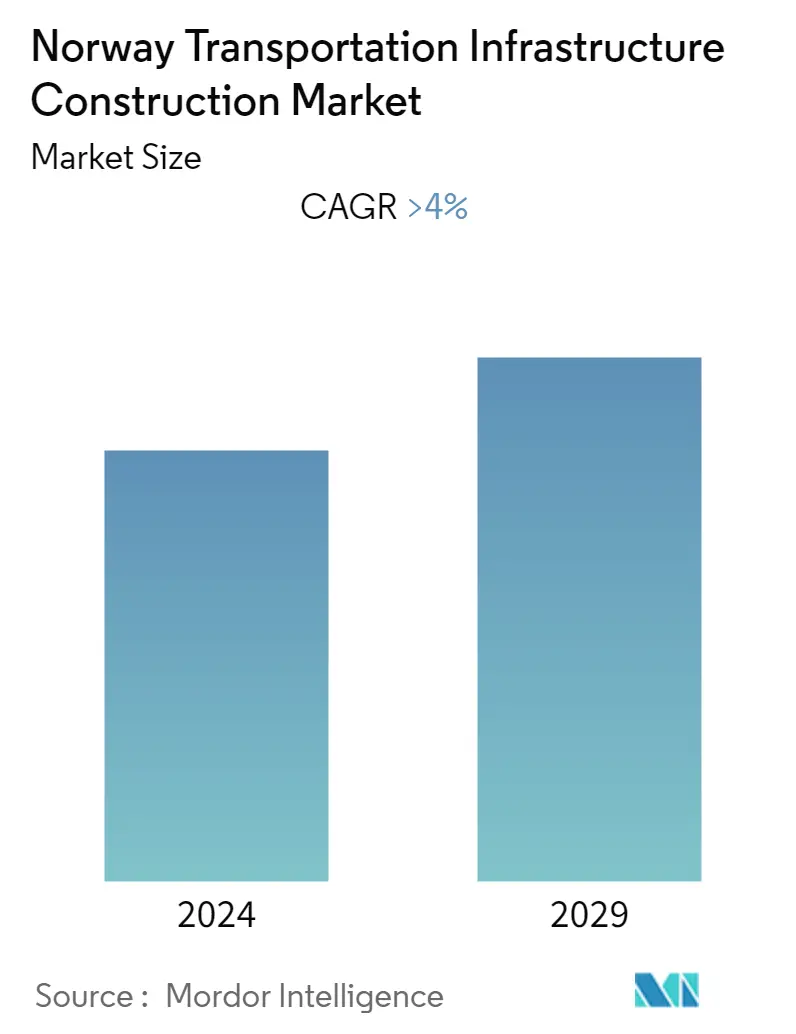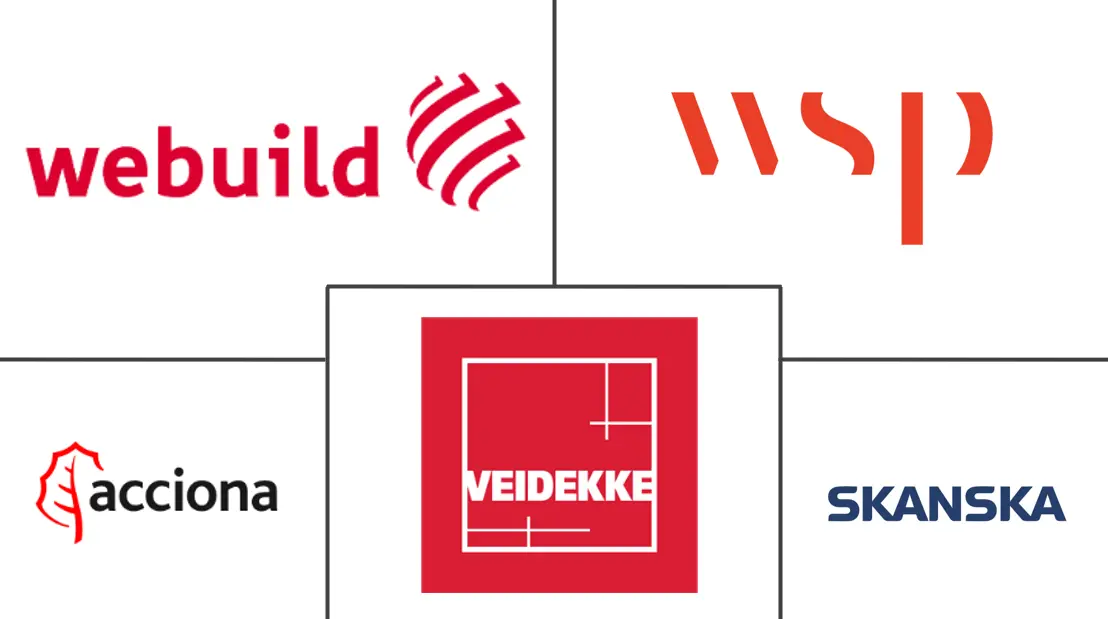Market Size of Norway Transportation Infrastructure Construction Industry

| Study Period | 2020 - 2029 |
| Base Year For Estimation | 2023 |
| Forecast Data Period | 2024 - 2029 |
| Historical Data Period | 2020 - 2022 |
| CAGR | > 4.00 % |
| Market Concentration | Medium |
Major Players
*Disclaimer: Major Players sorted in no particular order |
Norway Transportation Infrastructure Construction Market Analysis
Norway's Transportation Infrastructure Construction Market is expected to register a CAGR of more than 4% during the forecast period (2022-2027).
COVID-19 has impacted the transportation infrastructure sector. During the initial lockdown period, construction works were halted, and social distancing factors resulted in work delays in the country. Further, the industry is in the recovery stage, as the high vaccination rate in the country helped to limit the impact of COVID-19 on its population and economy.
Furthermore, the Norway government is implementing national transportation plans to achieve sustainable development goals by 2030. Also, the government has implemented several reforms to enable the transport agencies to utilize the resources allocated to the sector more efficiently. In addition, the government introduced portfolio management to change the dynamics of the Norwegian transport sector.
Norway's government will develop the national road network around 40 landslides/rockslides. Some of the initiated major projects are E18 Lysaker-Ramstadsletta, E39 Rogfast, Rv. 555 Sotrasambandet (Sotra Connection), E39 Lønset-Hjelset, E39 Betna-Vinjeøra-Stormyra, E16 Bjørum-Skaret, Rv. 4 Roa-Gran and E6 Helgeland South.
Norway Transportation Infrastructure Construction Industry Segmentation
Transportation infrastructure construction refers to a wide range of construction activities involving reforming existing constructions, building new infrastructures, and extending or demolishing projects. Furthermore, the Norway Transportation Infrastructure Construction market covers the growing trends, a complete background analysis of the transportation infrastructure construction market, which includes an assessment of the economy and contribution of sectors in the economy, market overview, market size estimation for key segments, and emerging trends in the market segments, market dynamics, and the impact of COVID - 19 on the market are covered in the report.
Norway Transportation Infrastructure Construction Market is segmented by Mode (Roadways, Railways, Airports, Ports, and Inland Waterways) and Key Cities (Oslo, Stavanger, and Bergen). The report offers market size and forecasts for Norway Transportation Infrastructure Construction Market in value (USD Billion) for all the above segments.
| By Mode | |
| Roadways | |
| Railways | |
| Airports | |
| Ports and Inland Waterways |
| By Key Cities | |
| Oslo | |
| Stavanger | |
| Bergen |
Norway Transportation Infrastructure Construction Market Size Summary
Norway's transportation infrastructure construction market is poised for significant growth, driven by government initiatives aimed at achieving sustainable development goals and enhancing the efficiency of transport agencies. The sector is recovering from the impacts of COVID-19, with construction activities resuming and projects progressing. The Norwegian government is actively developing the national road network and improving road and rail systems to reduce traffic congestion. Major projects like the E39 highway, which connects southern Norway to Trondheim and extends to Denmark, are central to these efforts. The E39 project, along with other significant undertakings such as the Rogfast tunnel and the Sotra Connection, underscores the country's commitment to expanding and modernizing its transportation infrastructure.
The market is characterized by a mix of domestic and international players, with companies like Webuild, Skanska, and ACCIONA holding substantial market shares. The government's National Transport Plan outlines a comprehensive investment strategy, allocating significant funds for national roads, tunnel upgrades, and new construction projects. This plan includes the development of complex tunnel systems and major road improvement projects, reflecting Norway's focus on creating an efficient, environmentally friendly, and safe transport system. The involvement of key industry players and the government's strategic investments are pivotal in shaping the future of Norway's transportation infrastructure construction market.
Norway Transportation Infrastructure Construction Market Size - Table of Contents
-
1. MARKET INSIGHTS AND DYNAMICS
-
1.1 Market Overview
-
1.2 Government Regulations and Initiatives
-
1.3 Supply Chain/Value Chain Analysis
-
1.4 Technology Snapshot and Digital Trends
-
1.5 Insights on Modernization of the Transportation Infrastructure Sector
-
1.6 Insights on Major Infrastructure Development Projects
-
1.7 Market Dynamics
-
1.7.1 Market Drivers
-
1.7.2 Market Restraints
-
1.7.3 Market Opportunities
-
-
1.8 Porter's Five Forces Analysis
-
1.9 Impact of COVID-19 on the Market
-
-
2. MARKET SEGMENTATION
-
2.1 By Mode
-
2.1.1 Roadways
-
2.1.2 Railways
-
2.1.3 Airports
-
2.1.4 Ports and Inland Waterways
-
-
2.2 By Key Cities
-
2.2.1 Oslo
-
2.2.2 Stavanger
-
2.2.3 Bergen
-
-
Norway Transportation Infrastructure Construction Market Size FAQs
What is the current Norway Transportation Infrastructure Construction Market size?
The Norway Transportation Infrastructure Construction Market is projected to register a CAGR of greater than 4% during the forecast period (2024-2029)
Who are the key players in Norway Transportation Infrastructure Construction Market?
Webuild, Skanska, ACCIONA, WSP and Veidekke are the major companies operating in the Norway Transportation Infrastructure Construction Market.

